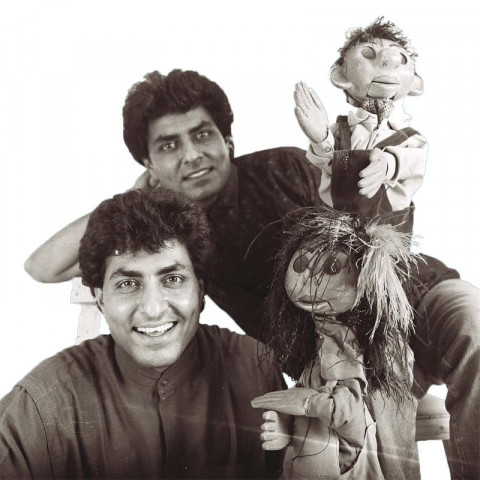Reviving puppetry: Hand in glove
Art students and theatres join forces to keep the tradition of string puppetry alive in Pakistan

Sadan and late Faizan Peerzada, co-founders of the Rafi Peer Theatre Workshop, have made several efforts to keep string puppetry alive in Pakistan. PHOTO COURTESY: YAMINA PEERZADA
Puppets deserve a bigger role in mainstream theatre. “The purpose is to keep the folktales alive. The younger generation should know about their roots and literary tradition,” says Faisal Malik, artistic director for Thespianz Theatre. According to Malik, there is a false perception that puppet shows are only for children. Various shows like Heer Ranjha and Umar Marvi mainly cater to adults, he says. Puppetry encourages both children and adults to be creative and makes people more empathetic towards a variety of situations, he explains. “The sole aim of our team is to attract audiences to watch theatre and be amused by the oldest form of puppetry,” he adds.

Yamina Peerzada, a graduate of the Royal Central School of Speech and Drama in London with a Masters in acting, is following in the footsteps of her late uncle Faizan Peerzada and father Sadan Peerzada, co-founders of the Rafi Peer Theatre Workshop (RPTW), to promote the art and contemporise it by conducting hands-on puppet-making workshops in schools across Pakistan. “We want to introduce the art of puppetry to children at a young age to make them experience the joy and pride puppeteers experience during their performances,” says Yamina, who is also part of the puppet show The Border, a Danish-Pakistani collaboration. “Children make their own puppets and give life to inanimate objects. The interesting thing is that even shy students shun the fear of being judged and happily participate,” she adds.
When the RPTW was launched in 1974, there were only two puppet theatres functioning on a daily basis in Karachi. But today the initiative has produced over 40 live puppet productions and four 13-part television puppet series for children, including Sim Sim Hamara. It also houses a puppet museum in its cultural complex. The multi-storeyed museum established in 2006 hosts puppets from 50 countries and facilitates the International Puppet Residency Program for youth and children. “Our aim is to develop college-level independent puppet groups to popularise the art,” says Yamina.
Although there is no dearth of talent in the art of puppetry, the profession continues to suffer in Pakistan. “During the production of Sim Sim Hamara, I saw a lot of potential in people, but many eventually move on to other things due to monetary reasons,” says Yamina. Since puppetry is associated purely with entertainment and has not been utilised effectively in advertisements, it is not considered a lucrative profession. Additionally, for the art to flourish it is important to appreciate and applaud puppeteers. Attracting a younger audience has become difficult though as parents are reluctant to let their children watch shows in public places. “We cannot invite foreign puppeteers and hold festivals with fanfare, hence we are restricted,” shares Tasneem Peerzada of Rafi Peer Theatre. So unless people wholeheartedly embrace puppetry it will be pushed off to the peripheries of art.
Sadaf Parvez is a freelance writer and blogger. She tweets @sadafpervez
Published in The Express Tribune, Sunday Magazine, May 3rd, 2015.



















COMMENTS
Comments are moderated and generally will be posted if they are on-topic and not abusive.
For more information, please see our Comments FAQ